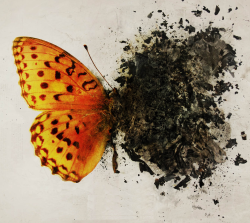Post-Traumatic Stress Disorder
 Overview
Overview
Once known as shell-shock or combat fatigue, post-traumatic stress affects more people than simply those who are war-weary veterans. Anyone who survives a traumatic or disturbing event may fall prey to this disorder. PTSD is currently thought to affect about 10 percent of people at some time in their lives.
Causes
Although the cause was once thought to be the result of seeing heavy and vicious combat, this disorder can happen to people who experience such events as a car accident, a sexual assault, a natural disaster or even the diagnosis of a life-threatening illness or disease. About one percent of women who experience a miscarriage end up suffering from PTSD.
A hormone called adrenaline is produced in response to stress. In people who have PTSD, adrenaline levels tend to remain high, causing irritability, tension, and an inability to relax. Insomnia is often found with PTSD. This added adrenaline can prevent the hippocampus, the part of the brain that processes memories, from performing its job correctly.
Prevention
The feeling of being powerless during a traumatic event is related to the risk of developing PTSD. Becoming active and focused on helping other people during combat or natural disasters can help lower the risk of developing the symptoms of PTSD. Expressing distress after the event in support groups can help some people avoid later symptoms.
Diagnosis
Some of the worst symptoms of PTSD include nightmares and vivid memories of the event, which cause the person to relive the event over and over. Because these events are painful, the person may become numb emotionally and try to avoid people and places that tend to remind them of the event.
Some people with PTSD are always "on guard," looking for the potential danger, which is a condition called hyper-vigilance. Depression, irritability, and physical symptoms such as diarrhea, headaches, irregular heartbeat and dependence on alcohol or drugs can occur. PTSD affects more women than men.
Unfortunately, children are not immune from PTSD. They can be prone to nightmares and may lose interest in the activities they once enjoyed. While playing, they may recreate the event that was traumatic for them. They may also suffer from stomach aches and headaches.
Treatment
Cognitive-behavioral therapy is often recommended for PTSD before medication is used. Exposure therapy has the person undergoing carefully-monitored repeated imaginings of the traumatic event in a safe and friendly environment. This helps the patient gain control of their fear. Desensitization uses a gradual approach, along with various relaxation techniques. "Flooding" is an exposure technique in which the patient confronts the fear all at once.
While it is still considered controversial, EMDR or eye movement desensitization and reprocessing has been shown to be effective in some cases. This type of therapy combines some of the aspects of exposure therapy with cognitive-behavioral therapy, along with rapid eye movements back and forth. During traumatic memories, the eye movements can create an alternation of attention. This process is believed to somehow aid the mind in processing the memories.
Group therapy can be helpful for some people. They meet with others with similar experiences and help to get over issues such as "survivors' guilt." Family therapy is often necessary as the family members are often affected by the PTSD and can benefit as much as the patient from the therapy.
Hypnotherapy can also help to reduce anxiety, even though no reliable research studies have compared hypnosis to be a proven effective method. This can be used as an additional therapy along with cognitive-behavioral therapy for PTSD.
The most typically prescribed drugs for PTSD are antidepressants known as selective serotonin reuptake inhibitors. These medications do not cure the problem but can relieve some of the symptoms. Antianxiety drugs such as the benzodiazepines are often used to treat the anxiety caused by PTSD, but are of limited benefit as they can lead to drug dependence.
Yoga and other relaxation techniques are also frequently used. Massage can help to reduce some of the symptoms of anxiety associated with PTSD.
When a person is suffering from periods of stress and trauma, it is very important to be conscious of nutrition intake. Diets should be high in fiber, full wholesome and organic foods. Because stress thickens the blood, foods with a blood thinning effect are good, such as ginger, garlic, and cantaloupes.
Anti-stress nutrients are also recommended, such as B-complex vitamins. One B member, pantothenic acid, is particularly important as it quickly dissipates in the body during stressful situations.
Vitamin C is also important for its role as an antioxidant that helps the body against stress reactions and a variety of associated diseases. Beta carotene is another antioxidant that helps protect the body during periods of stress. Minerals that are helpful include zinc, potassium, chromium and magnesium.
These substances can also be found in foods such as broccoli and kale (pantothenic acid), and red pepper, strawberries and collard greens for vitamin C.
References
- Bratman, S. (1998). The Alternative Medicine Ratings Guide: an expert panel rates the best treatments for over 80 conditions. New York: Crown Publishing Group (1998)
- Brown, L. (1999). Alternative Medicine. London : Teach Yourself
- Carmen, R. (2009). The consumer handbook on hearing loss and hearing aids : a bridge to healing. Sedona, Ariz. : Auricle Ink Publishers
- Deepak Chopra, M.D. (2002). Alternative Medicine: The Definitive Guide. Puyallup, Wash. : Future Medicine Pub.
- Duke, J. (2003). The Green Pharmacy: Herbal remedies for common diseases and conditions from the world's foremost authority on healing herbs. London : Rodale
- Servan-Schreiber, D.(2006). The Encyclopedia of New Medicine: Conventional & Alternative Medicine For All Ages. London : Rodale
Posted in Post-Traumatic Stress Disorder
Ask a Question Or Join a Discussion


